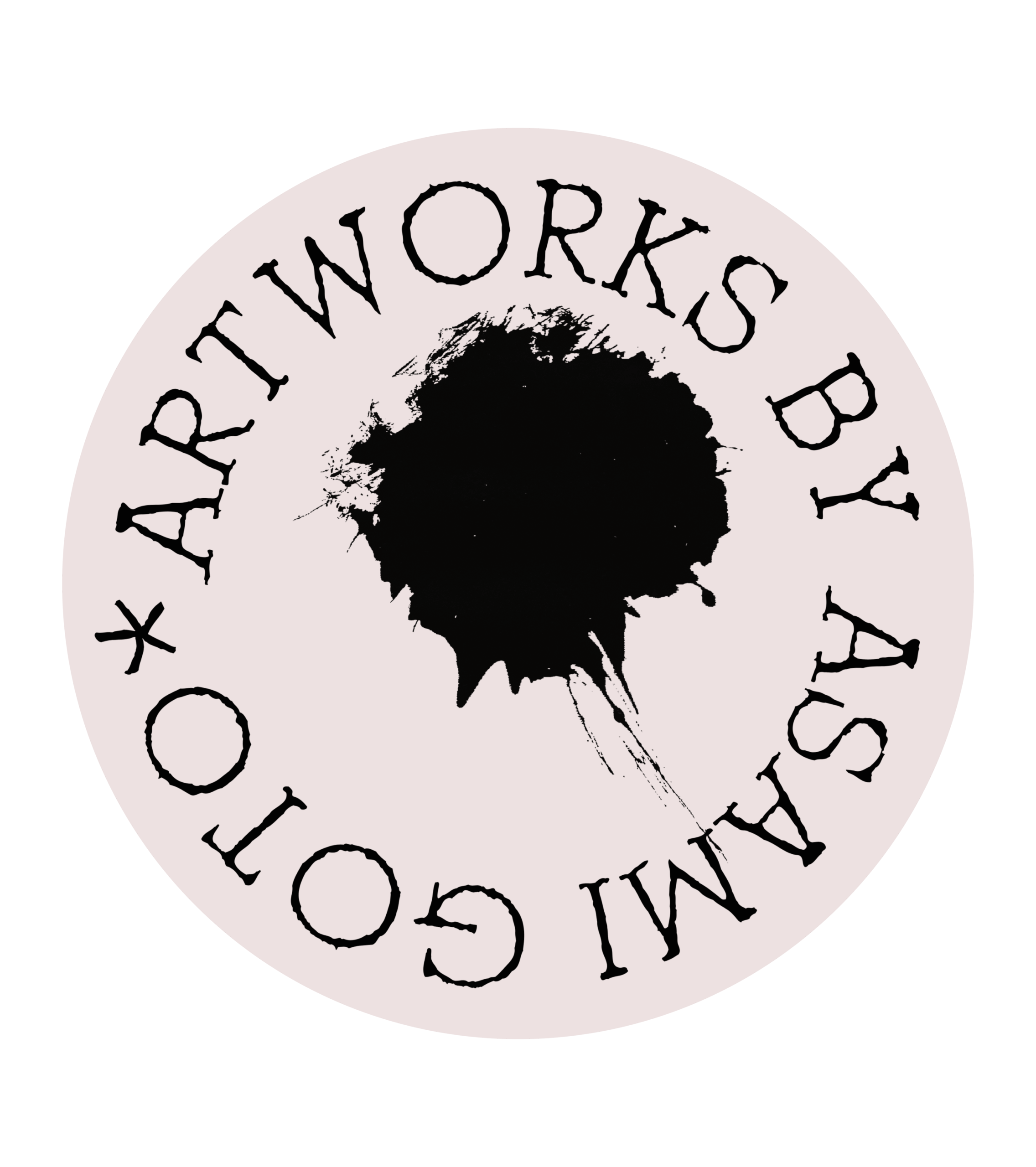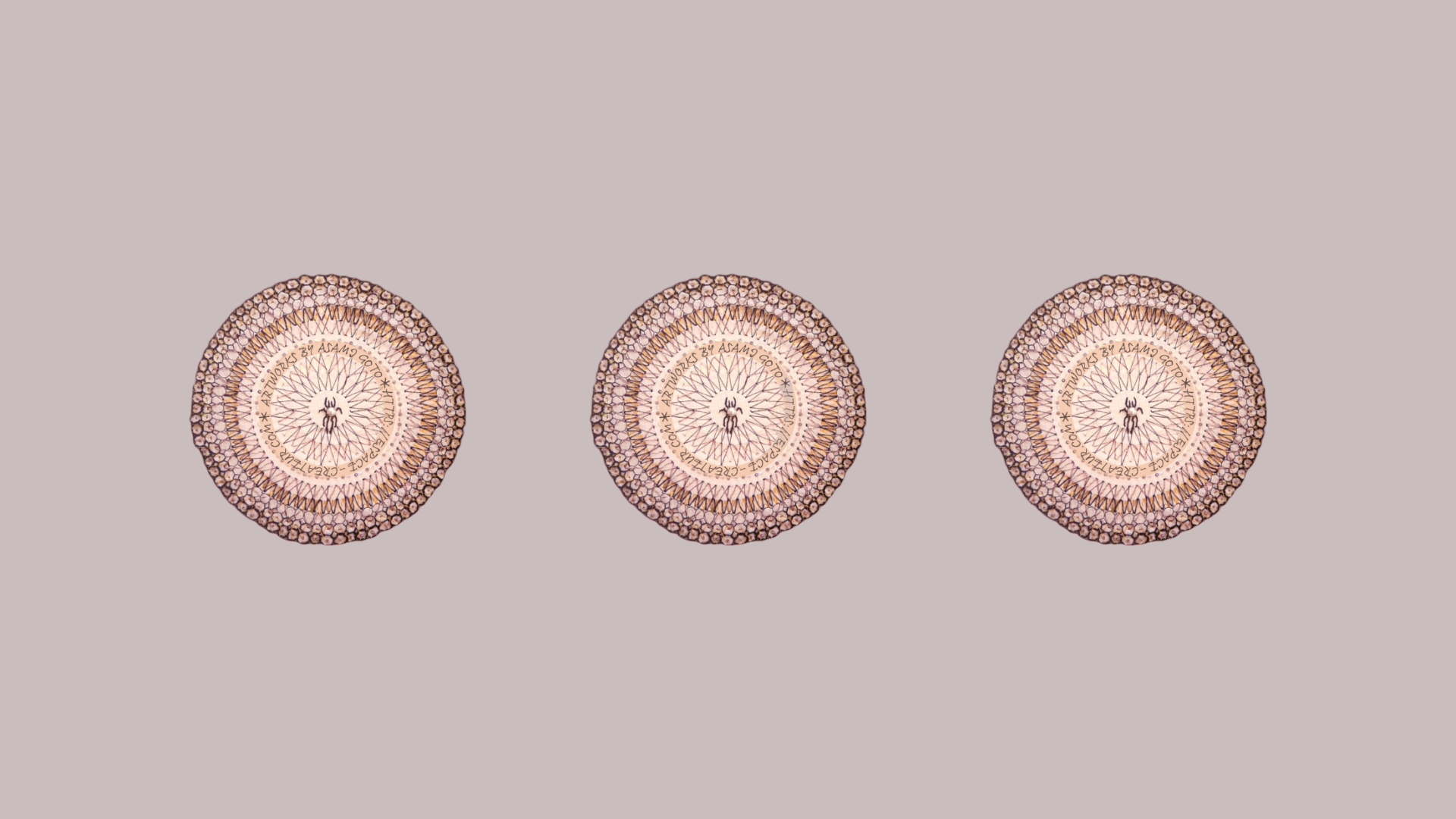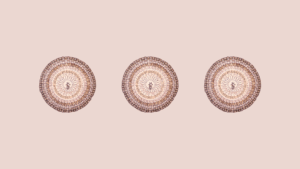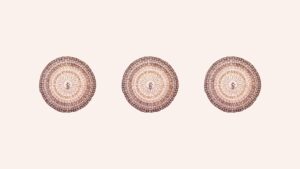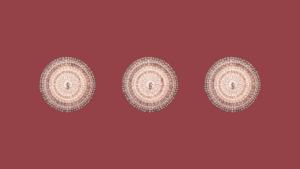古代から受け継がれる「かたち」の意味
たとえば、円・三角形・螺旋といった図形は、単なる装飾ではなく、
古代から「宇宙の法則」を映す鏡として象徴的な意味を与えられてきました。まず、円は始まりも終わりも持たない「永遠」の象徴であり、あらゆるものを包みこむ「調和」と「全体性」のかたちです。
一方、三角形は、地と天、人と神、物質と精神をつなぐ「上昇」と「均衡」の象徴として、建築や祭祀の構造に宿ってきました。
そして、螺旋は絶えず生成と消滅を繰り返す「生命の循環」、あるいは銀河の運動にも通じる「宇宙的リズム」を象徴しています。
このように、これらの形は文明や宗教を超えて、人類の深層意識に刻まれた**原型(アーキタイプ)**でもあります。だからこそ、私たちは無意識のうちに、その形を通して世界の秩序や自らの存在を読み取っているのかもしれません。
円 ─ 永遠と調和のかたち
円は始まりも終わりも持たない形として、古くから「永遠」や「完全性」の象徴とされてきました。
太陽や月の形に代表されるように、自然界においても円は周期や循環を示します。さらに、古代ギリシアでは「理想のかたち」とされ、宗教的な文脈では宇宙や神性を表す図像として、繰り返し登場してきました。
一方で、現代においても円形の幾何学アートを見つめることは、心に静けさをもたらし、自然に呼吸のリズムを整えていく体験となります。
たとえば、円は内と外を隔てる普遍的な境界であり、その繰り返し現れる形は、無意識のうちに「調和」の感覚を呼び覚まします。
このように、作品を眺めることで心のバランスを取り戻したり、瞑想のような集中と安らぎが生まれることがあります。まるで視覚を通じて内なる空間を呼び覚ますように、円の形は観る人の内奥に静かな調律を響かせるのです。
三角形 ─ 均衡と上昇のかたち
三角形は最小単位でありながら、最も安定した形です。
建築におけるトラス構造やピラミッドに象徴されるように、その形は「強さ」と「バランス」を示します。また、頂点へと向かう鋭角は「上昇」や「志向性」の象徴として、古来より精神的な意味を与えられてきました。一方で、三角形を基調とする幾何学アートは、安定と緊張という相反する要素をひとつに抱えたかたちです。
たとえば、大地に根差す静けさを支えながら、同時に天へと伸びゆく力を象徴します。その構造は、心の奥に眠るエネルギーをやわらかく呼び覚まし、再び立ち上がるための力を穏やかに授けてくれる――
そんな印象を与えることでしょう。
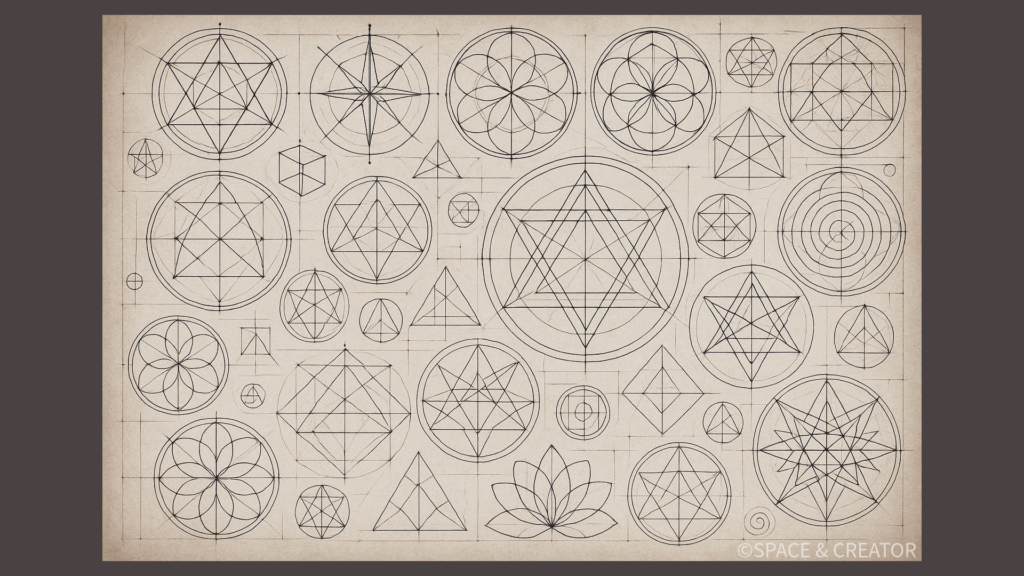
螺旋 ─ 生命と時間のかたち
螺旋は自然界に広く見られる普遍的なパターンです。
貝殻や銀河、DNAの二重らせんなどに共通するのは、「成長」「進化」「循環」というイメージです。さらに、古代文化では螺旋は「生命の象徴」として扱われ、再生や変容のモチーフとしても用いられてきました。
一方で、螺旋を基調とする幾何学アートは、古来より「生命のかたち」や「宇宙の運行」を象徴してきました。中心から外へ、そして外から再び中心へと続くその流れは、個と全体、自己と世界を結ぶ往還のリズムを思わせます。
たとえば、視線をその中心にあずけるうちに、時の流れや大いなる循環の中に自らが包まれていることを感じ、「生きている」という感覚が静かに強まっていく――そんな印象をもたらすことでしょう。
四角 ─ 基盤と秩序のかたち
四角形は「地」「基盤」「秩序」を象徴します。
古代の都市設計や建築においては基礎単位とされ、安定と永続性のイメージを担ってきました。一方で、四角を基調とする幾何学アートは、形を固定することで、揺らぎの中に確固たる土台を示す造形です。その直線が織りなす構造は、混沌とした流れに安定をもたらし、空間に静かな秩序を刻み込みます。
たとえば、その堅牢な輪郭は大地のような安らぎを思わせます。同時に、未来へ向かう建築的な力をも秘めているのです。
このように、四角形は揺らぎや不確かさに満ちた日常の中で、心を落ち着かせる「基盤」を取り戻させてくれる――そんな印象をもたらすことでしょう。
多角形 ─ 複雑性と共同体のかたち
五角形や六角形といった多角形は、多様性や複雑性を表す形です。
たとえば、蜂の巣の六角形は自然界における合理性の象徴であり、中世以降の建築や装飾にも頻繁に取り入れられました。一方で、多角形を基調とする幾何学アートは、単純な秩序を超えて、複数の力が共存する姿を映し出しています。角ごとに異なる方向性を持ちながらも、全体としてひとつの形を成すその構造は、個と個が響き合い、調和を築く営みを象徴しています。
このように、そのかたちはまるで社会や共同体の比喩のようでもあります。多様な存在が交わり、時に緊張を孕みながらも均衡を保ち、共にひとつの世界を織りなしていくのです。
視線を重ねるほどに、多角形は「違いの中に宿る秩序」を示し、見る者に共生の可能性を静かに語りかけてくることでしょう。
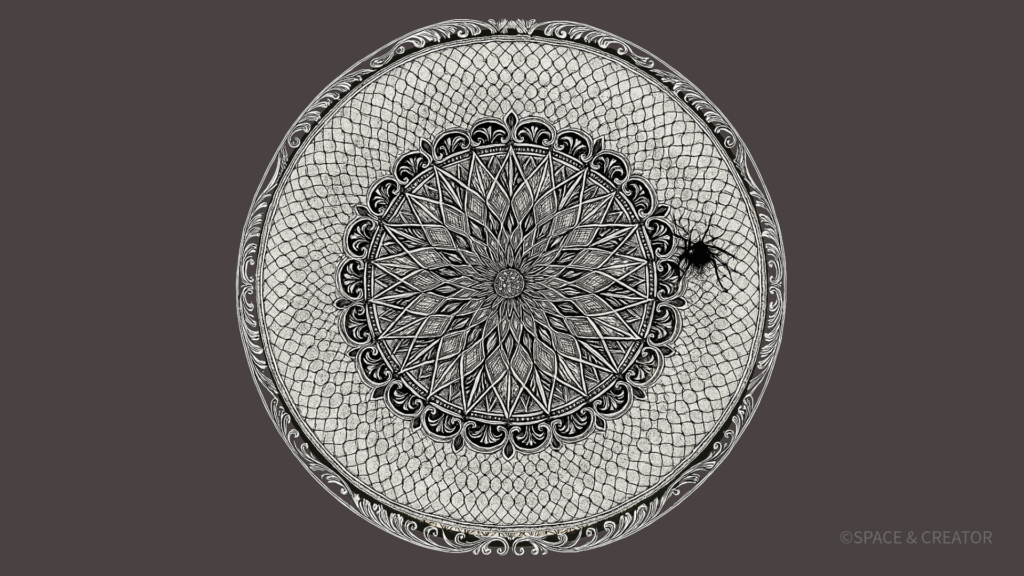
十字 ─ 交差と中心のかたち
十字は東西南北や天地を示す象徴であり、世界の中心を指し示す形です。
宗教的文脈では「聖なるしるし」として定着しましたが、より普遍的には「交差」や「出会い」のモチーフとしても解釈できます。一方で、十字を基調とする幾何学アートは、複数の方向性をひとつの中心へと収束させる造形です。
水平と垂直の線は、拡散と統合という相反する力を同時に示し、空間に「交わりの場」を刻み込みます。たとえば、その形は天地をつなぐ軸であり、また、東西南北を示す道標でもあります。視線をあずけると、広がっていく意識がやがて中心へと呼び戻され、散らばる思考や感情が静かにひとつに整えられていく感覚が生まれるでしょう。
このように、十字は単なる形にとどまらず、「つながり」と「調和」を映し出す象徴です。その交差点は、内なるバランスを静かに呼び戻すきっかけとなるでしょう。
星形 ─ 光と超越のかたち
星形は光そのものを象徴する形です。
五芒星や六芒星は古代から魔術的・宗教的な記号として用いられ、「超越」や「守護」の意味を担ってきました。また、中世の図像学では「人間の理想像」と重ねられることもありました。一方で、星を基調とする幾何学アートは、闇の中に光を切り開くかたちです。放射状に広がる線は、内側に秘められた力が外界へと解き放たれる様子を映し出し、心に希望や超越への感覚を呼び覚まします。
たとえば、星は古来より航海の道標として人々を導き、また願いや祈りの象徴として夜空に見上げられてきました。その形を見つめるとき、視線は自然に中心から外へと導かれ、閉ざされた感覚がほどけ、未来へと開かれていくような広がりを感じさせます。
このように、星の造形はその体験を視覚の中に刻み込み、見る者に「希望の種子」を静かに手渡してくれるのです。
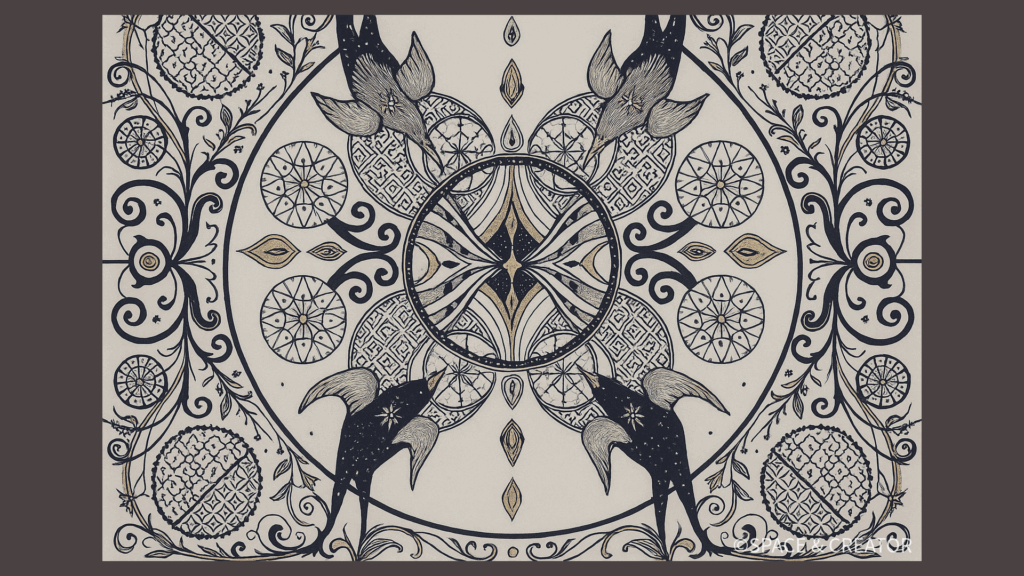
次回予告
次回は、自然界にひそむ「フラクタル」の世界を取り上げます。木々の枝ぶりや葉脈、雪の結晶──。小さなかたちの中に大きなかたちが映り込み、同じリズムが繰り返されるその構造は、生命の秩序そのものを物語っています。
人の手による創造と自然のかたちがどのように響き合うのかを探っていきたいと思います。
五島アサミ(Asami GOTO)
English
The Meaning of Forms Handed Down from Antiquity
Circles, triangles, and spirals — these shapes are far more than mere decoration. Since ancient times, they have been imbued with symbolic meanings, serving as mirrors that reflect the laws of the cosmos.
The circle, with neither beginning nor end, stands as a symbol of eternity, embodying the harmony and wholeness that encompass all things.
The triangle represents ascent and balance, linking earth and heaven, humanity and divinity, matter and spirit — a form deeply embedded in architecture and sacred ritual.
And the spiral, eternally unfolding and returning, signifies the cycle of life and the cosmic rhythm that resonates with the motion of galaxies.These forms transcend civilizations and religions; they are archetypes engraved in the collective unconscious of humankind.
Through them, we may unconsciously perceive the order of the universe — and perhaps, glimpse the very structure of our own existence.
Circle — The Form of Eternity and Harmony
The circle, having neither beginning nor end, has long been regarded as a symbol of eternity and wholeness.
In nature, its form appears again and again — in the sun, the moon, and in the endless cycles that govern all living things.In ancient Greece, it was considered the ideal form, while in religious contexts it often represented the cosmos or the divine.
To gaze upon circular geometry in art is to experience a quieting of the mind — a natural attunement of one’s inner rhythm, much like the deep calm of meditation.The circle defines a universal boundary between the inner and the outer, and its recurring shape awakens within us an unconscious sense of harmony.
Through the act of contemplation, one may regain inner balance, finding serenity and focus.
As if bridging the visible and the invisible through sight itself, the circle resonates as a gentle tuning within the depths of the observer’s soul.
Triangle — The Form of Balance and Ascent
The triangle, though composed of the fewest sides, is among the most stable of all forms.
From the truss structures of architecture to the ancient pyramids, it has long symbolized strength and balance.At the same time, its upward-pointing apex evokes ascent — a striving toward the higher, both physical and spiritual.
Geometry based on the triangle embodies a delicate union of stability and tension: it grounds itself in the stillness of the earth, even as it reaches toward the heavens.Its structure seems to gently awaken the dormant energies within the heart, bestowing a quiet strength —
a strength that allows one to rise once more, softly yet resolutely.
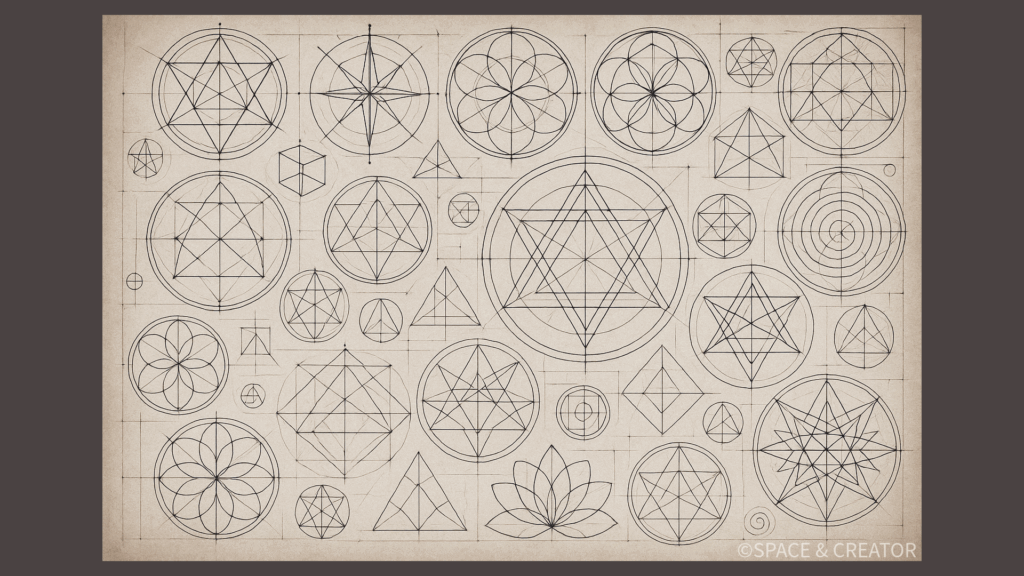
Spiral — The Form of Life and Time
The spiral is a universal pattern found throughout nature — in seashells, galaxies, and the double helix of DNA.
What unites these forms is a sense of growth, evolution, and continuity.In ancient cultures, the spiral was revered as a symbol of life, representing renewal and transformation.
Geometry based on the spiral has long been seen as a reflection of the form of life itself and the movement of the cosmos.Its motion — expanding outward from the center, then returning once more — suggests the rhythmic exchange between the individual and the whole, the self and the universe.
As one’s gaze follows the spiral, there arises a quiet awareness of being enfolded within the vast flow of time and existence —
a deep, gentle awakening to the simple truth of being alive.
Square — The Form of Foundation and Order
The square symbolizes earth, foundation, and order.
Since ancient times, it has served as the fundamental unit of cities and architecture, embodying stability and permanence.Geometry based on the square conveys a sense of groundedness within flux — a structure that defines form, anchoring the transient in something enduring.
Its network of straight lines brings calm to chaos, inscribing quiet order into space itself.The solidity of its contours evokes the serenity of the earth, yet within it lies an architectural energy that reaches toward the future.
As one contemplates this form, there arises a gentle sense of grounding —
a momentary return to stillness amid the uncertainties of everyday life.
Polygon — The Form of Complexity and Community
Polygons such as pentagons and hexagons embody diversity and complexity.
The hexagonal cells of a honeycomb stand as symbols of natural rationality —
a pattern that has inspired architecture and ornamentation since the Middle Ages.Geometry based on the polygon transcends simple order, revealing a space where multiple forces coexist and intertwine.
Each angle extends in its own direction, yet together they form a single, unified shape —
a structure that mirrors the harmony born from the resonance between individuals.In this sense, the polygon becomes a metaphor for society and community:
a gathering of diverse beings who, even amid tension, sustain balance and weave a shared world.
The more one gazes upon it, the more the form seems to whisper of order within difference,
quietly inviting reflection on the possibility of coexistence.

Cross — The Form of Intersection and Center
The cross is a symbol that marks the four directions — east, west, north, and south — and points toward the center of the world.
While it has long been established as a sacred sign in religious contexts, its meaning extends further, evoking themes of intersection and encounter.Geometry based on the cross gathers multiple directions into a single point of convergence.
Its horizontal and vertical lines express opposing yet complementary forces — expansion and integration — inscribing a quiet field of connection within space.The form itself serves as both an axis linking heaven and earth, and a compass that orients us within the world.
As one’s gaze lingers upon it, awareness expands outward only to be drawn gently back to the center,
and scattered thoughts and emotions begin to settle into calm alignment.The cross, then, is more than a mere shape; it is a symbol of connection and harmony.
At its point of intersection, one may rediscover an inner equilibrium —
a still center within the movement of all things.
Star — The Form of Light and Transcendence
The star is a form that symbolizes light itself.
From ancient times, pentagrams and hexagrams have been used as magical or sacred symbols, representing transcendence and protection.
In medieval iconography, the star was sometimes associated with the ideal image of humankind.Geometry based on the star evokes the act of light breaking through darkness.
Its radiating lines suggest an inner power unfolding toward the outer world — an awakening of hope and the sense of something beyond the human realm.Since antiquity, stars have guided travelers across the seas and served as symbols of wishes and prayers rising toward the night sky.
When one gazes upon the form of a star, the eye is drawn naturally from the center outward,
and a feeling of release and openness arises — as though the heart itself were turning toward the future.The geometry of the star engraves this experience into vision,
quietly offering to the viewer a seed of hope that continues to shine within.

Next Episode
In the next chapter, we will explore the hidden world of fractals in nature —
the branching of trees, the veins of leaves, the crystalline symmetry of snow.Within these patterns, small forms mirror larger ones,
and rhythms repeat as if revealing the very order of life itself.We will look into how human creation and the forms of nature resonate with one another —
and how, in that resonance, the boundary between art and life quietly dissolves.五島アサミ(Asami GOTO)
Contemporary Artist / Nihonga & Geometric Embroidery + Sumi Art / Tokyo, Japan
